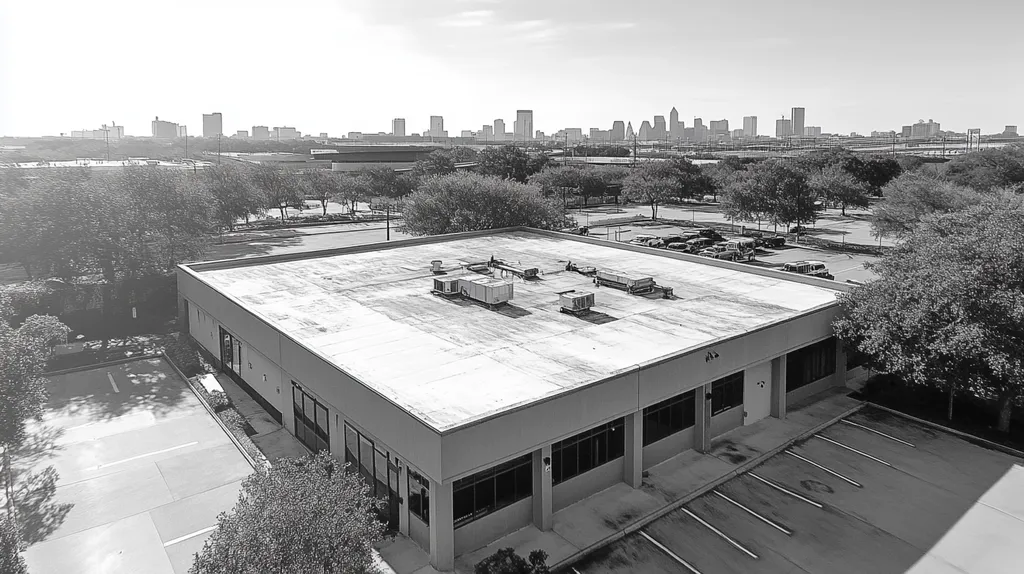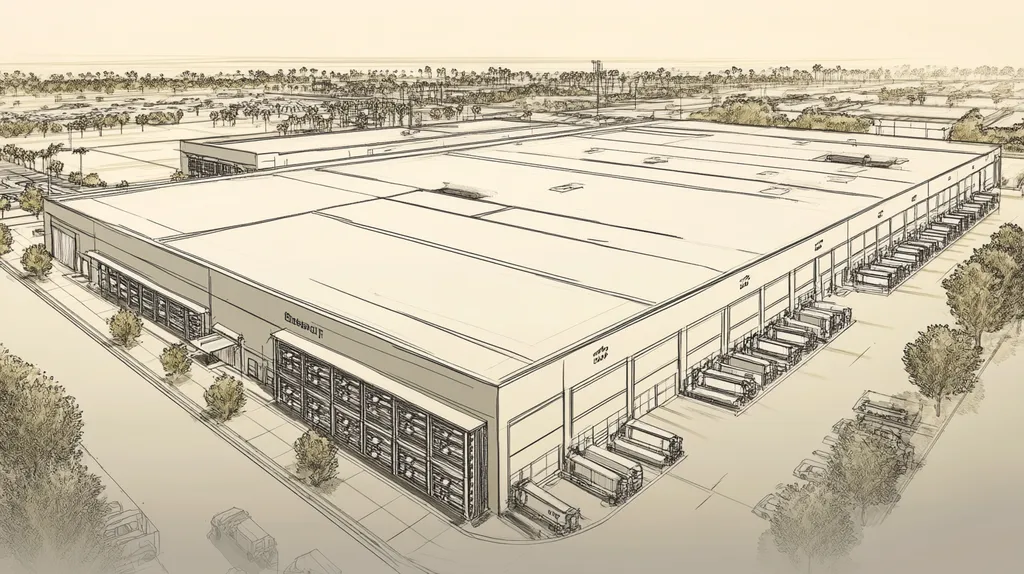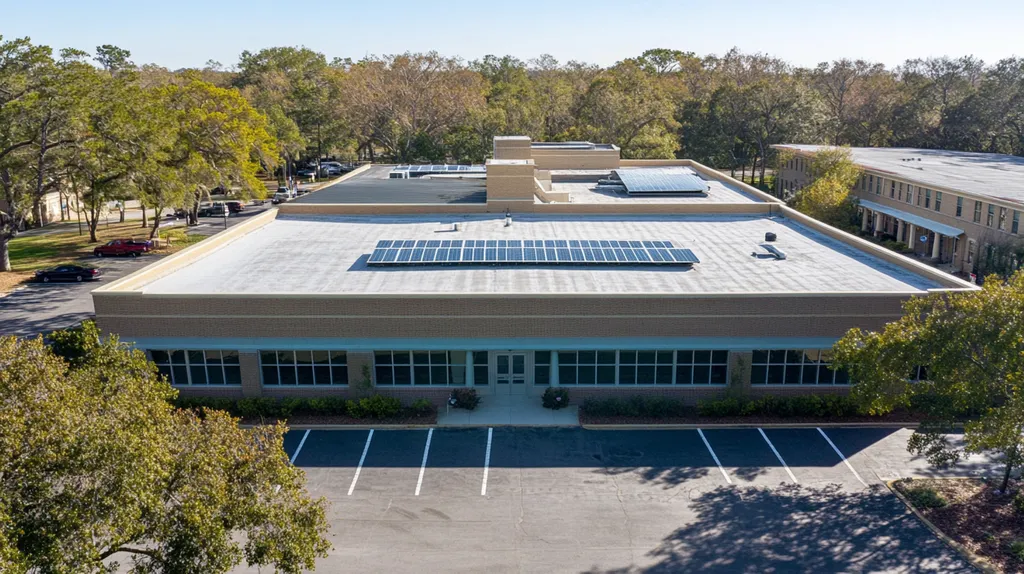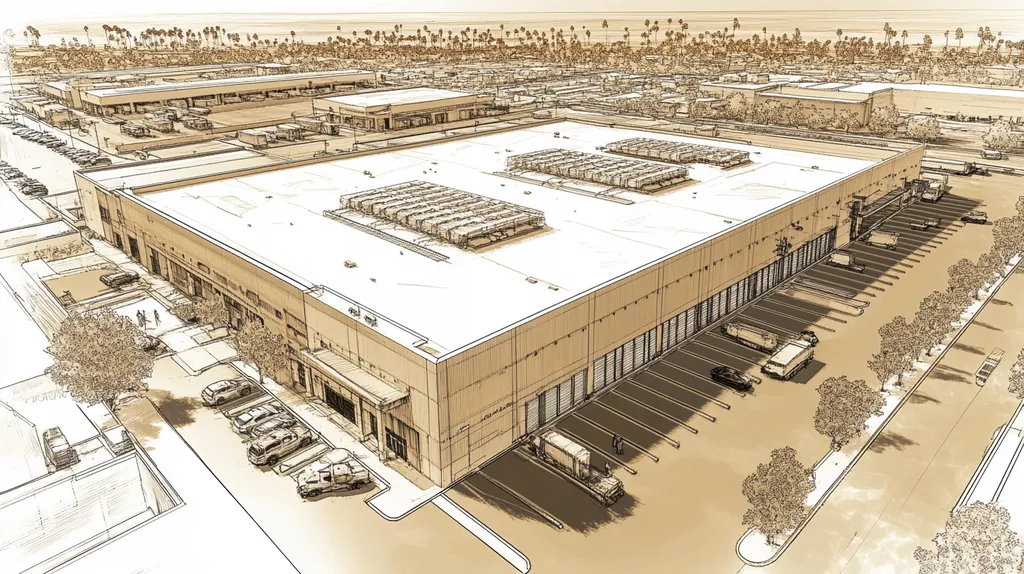Every minute of downtime during industrial roof work costs facilities an average of $100-500 in lost productivity, with total project disruptions often exceeding $250,000 for poorly managed installations.
For facility managers and building owners, maintaining operations during essential roofing work isn’t just about convenience – it’s a critical business imperative that directly impacts the bottom line.
This comprehensive guide examines proven strategies for managing disruptions during industrial roof projects, from initial planning through final installation, helping you protect both your facility’s operations and your project’s success.
SECTION 1: THE BASICS EXPLAINED
Industrial roofing projects can bring operations to a standstill if not managed properly. Every hour of downtime typically costs facilities between $1,000 and $10,000 in lost productivity. Understanding and implementing proper disruption management strategies isn’t just about keeping the roof intact – it’s about protecting your bottom line and maintaining business continuity during critical maintenance work.
What It Is (In Plain Language)
Disruption management involves coordinating roofing work around your facility’s operational needs. This means scheduling repairs, replacements, and maintenance in ways that minimize interference with daily business activities.
The process requires careful orchestration of multiple elements: worker access, material staging, equipment placement, and safety protocols. Each element must be precisely timed to avoid creating bottlenecks in facility operations.
Effective management also includes establishing clear communication channels between roofing crews, facility staff, and building occupants. This ensures everyone knows what to expect and how to adapt their routines during the project.
Most importantly, it includes having contingency plans ready for unexpected challenges like weather delays or material shortages. These backup plans help maintain project momentum while protecting operational continuity.
Why It Matters (To Your Building)
Best practices in roofing project management directly impact building performance and safety across multiple weather conditions. Proper planning ensures that roofing work enhances rather than compromises your facility’s protective systems. (source: Insurance Institute for Business & Home Safety)
Poorly managed disruptions can cascade through your entire operation. A simple leak during roof work can damage inventory, shut down production lines, or create unsafe working conditions that force facility closure.
The financial implications extend beyond immediate repair costs. Lost productivity, missed deadlines, and damaged customer relationships can impact your business long after the roofing project is complete.
Environmental control systems, particularly in manufacturing or storage facilities, require consistent operation. Even brief interruptions can compromise product quality or regulatory compliance.
How It Works
Successful disruption management starts with a detailed site assessment and impact analysis. This identifies critical operational areas, scheduling constraints, and potential risk factors before work begins.
The process then moves to creating detailed work zones and timelines. These specify exactly where and when roofing activities will occur, allowing facility managers to adjust operations accordingly.
Implementation involves daily coordination meetings between roofing crews and facility staff. These sessions review upcoming work, address concerns, and adjust plans based on changing conditions.
Throughout the project, progress monitoring tools track both construction milestones and operational impacts. This data helps optimize work sequences and validate that disruption management strategies are effective.
Regular assessment of these strategies ensures continuous improvement, with adjustments made based on real-world performance and changing facility needs.
SECTION 2: PRACTICAL APPLICATIONS
Industrial roofing projects present unique challenges that can severely impact operations, with disruptions costing facilities up to $50,000 per day in lost productivity and damaged inventory. Even minor interruptions can trigger ripple effects throughout supply chains and production schedules. Understanding and implementing practical disruption management strategies is essential for maintaining business continuity while ensuring roof work progresses efficiently.
Common Uses & Examples
Material staging represents one of the most critical aspects of disruption management. Strategic placement of roofing supplies and equipment must account for facility access points, loading dock schedules, and emergency routes to prevent operational bottlenecks.
Advanced waterproofing techniques using self-adhering polymer-modified bitumen membranes provide superior protection during phased work, significantly reducing the risk of water infiltration and associated disruptions. (source: Insurance Institute for Business & Home Safety)
Zoned work schedules allow crews to complete sections during planned downtimes, such as overnight shifts or scheduled maintenance periods. This approach maintains productivity while minimizing impact on daily operations.
Mobile containment systems and temporary weather protection enable work to continue during marginal conditions without compromising interior environments or ongoing processes.
When You Need It Most
Critical production periods demand heightened attention to disruption management. Facilities must carefully coordinate roof work around peak manufacturing times, product launches, or seasonal surges in activity.
Weather-sensitive operations require special consideration during roof projects. Temperature-controlled environments, clean rooms, and precision manufacturing areas need robust protection against environmental exposure.
Emergency repairs present unique challenges that test disruption management systems. Having pre-established protocols for urgent situations helps maintain control even during unexpected events.
Facility expansions or renovations necessitate comprehensive disruption strategies to prevent conflicts between different construction activities while maintaining existing operations.
Interactions With Other Systems
Roofing work directly impacts HVAC performance through altered air flows and temporary system shutdowns. Careful coordination prevents temperature fluctuations that could affect sensitive equipment or processes.
Lightning protection systems require special attention during roof modifications. Temporary measures must maintain building safety while accommodating construction activities.
Fall protection anchors and safety systems need integration with ongoing operations. Strategic placement ensures worker safety without creating obstacles for facility staff.
Building automation systems often require adjustment during roofing projects. Monitoring and control parameters must adapt to temporary conditions while maintaining essential building functions.
SECTION 3: KEY TERMINOLOGY DECODED
Clear understanding of roofing terminology can mean the difference between project success and costly failures in industrial settings. When facility managers misinterpret technical specifications or measurement standards, it can lead to materials waste, installation errors, and budget overruns reaching six figures. Mastering essential roofing terms, measurements, and industry-specific language ensures better project outcomes and helps maintain operational continuity during roof work.
Essential Terms Explained
Understanding roof membrane types is crucial for durability and performance. Single-ply membranes like TPO and EPDM offer different benefits for various facility types, while built-up roofing systems provide multi-layer protection for high-traffic areas.
A sealed roof deck with self-adhering polymer-modified bitumen membrane provides superior protection against water infiltration when properly installed. This technology significantly reduces leak potential during both installation and long-term operation. (source: Insurance Institute for Business & Home Safety)
Penetrations and flashings represent critical components requiring special attention. These areas where pipes, vents, or equipment pass through the roof membrane need proper sealing to maintain system integrity.
Understanding substrate materials and their characteristics helps predict potential challenges. Wood, concrete, and metal decking each require different preparation methods and attachment systems.
Industry Jargon Translated
Core terminology often creates confusion during project planning. “Mil thickness” refers to membrane density, with higher numbers indicating greater durability and puncture resistance.
“Uplift resistance” describes a roof system’s ability to withstand wind forces. This rating becomes especially important in areas prone to severe weather events.
“Thermal movement” refers to the expansion and contraction of roofing materials due to temperature changes. Proper accommodation of this movement prevents membrane tears and seam failures.
“Cool roof” systems reflect more sunlight and absorb less heat than standard roofs. Understanding these performance metrics helps facility managers make climate-appropriate choices.
Measurement & Units Simplified
Square footage calculations form the foundation of roofing projects. One “square” equals 100 square feet, but waste factors typically add 10-15% to material requirements.
Slope measurements use ratio expressions like 1:12 or 2:12. These numbers indicate vertical rise per foot of horizontal run, directly affecting drainage and material choices.
Load calculations consider both dead loads (permanent weight) and live loads (temporary weight). These measurements ensure structural integrity during and after installation.
Wind uplift ratings use pounds per square foot (psf). Higher ratings indicate better resistance to wind forces, with requirements varying by building height and location.
SECTION 4: DECISION FACTORS
Decision-making during industrial roofing projects can mean the difference between seamless operations and costly shutdowns. Studies show that poor material choices and inadequate planning lead to disruptions costing facilities an average of $45,000 per day in lost productivity. Understanding the interplay between costs, performance requirements, and longevity helps facility managers make choices that minimize operational impact while maximizing roof system effectiveness.
Cost Considerations
Initial project costs represent only a fraction of the total financial impact of roofing decisions. Short-term savings on materials or installation can lead to exponential increases in maintenance expenses and operational disruptions over time.
Proper self-adhering polymer-modified bitumen membranes meeting ASTM D1970 requirements provide superior protection against water infiltration, significantly reducing the risk of costly repairs and business interruptions. (source: Insurance Institute for Business & Home Safety)
Labor costs vary significantly based on installation complexity and project timeline requirements. Rush installations typically command premium pricing while potentially compromising quality and increasing future maintenance needs.
Hidden costs often emerge from inadequate disruption management planning. These can include temporary facility modifications, additional security measures, and overtime labor charges for working during off-hours.
Warranty coverage represents another crucial cost factor. Premium materials typically offer longer coverage periods and more comprehensive protection against defects and failures.
Performance Trade-offs
Material selection directly impacts system performance and operational continuity. Higher-grade materials generally offer better resistance to weather events, mechanical damage, and chemical exposure.
Installation methods affect both immediate and long-term performance. Mechanically fastened systems may offer quicker installation but can be more susceptible to wind uplift compared to fully adhered applications.
Energy efficiency considerations often compete with other performance requirements. Reflective coatings may reduce cooling costs but might not provide optimal durability in high-traffic areas.
System compatibility with existing infrastructure influences overall performance. New materials must integrate seamlessly with current drainage, penetrations, and edge details to prevent failure points.
Maintenance requirements vary significantly between different roofing solutions. Systems requiring frequent maintenance create more opportunities for operational disruptions.
Lifespan & Durability Factors
Environmental conditions play a crucial role in determining system longevity. UV exposure, temperature fluctuations, and chemical emissions from facility operations all impact material degradation rates.
Traffic patterns and roof access requirements affect wear patterns. Areas supporting mechanical equipment or requiring regular maintenance need enhanced durability considerations.
Material thickness and reinforcement options directly correlate with system lifespan. Stronger membranes and better substrate preparation typically result in longer service life.
Edge detail design and execution significantly impact system durability. Proper terminations and flashings prevent premature failure and reduce maintenance requirements.
Future facility modifications must factor into durability planning. Systems should accommodate potential expansions or equipment changes without compromising long-term performance.
SECTION 5: COMMON CHALLENGES
Industrial roofing projects face complex challenges that can severely impact operations and profitability. Studies show that unmanaged disruptions during roof work typically increase project costs by 65% and extend completion times by 3-4 weeks. Understanding and preparing for common obstacles helps facility managers maintain control over projects while protecting operational continuity.
Frequent Problems & Solutions
Weather-related disruptions represent the most common challenge, affecting nearly 40% of industrial roofing projects. Strategic scheduling and phase planning can minimize exposure during vulnerable periods.
Material staging and logistics issues frequently create bottlenecks that impact both roofing work and facility operations. Implementing detailed delivery schedules and establishing dedicated staging areas helps maintain workflow efficiency.
Coordination conflicts between roofing crews and facility staff often lead to unnecessary delays. Daily planning meetings and clear communication protocols ensure all parties understand their roles and responsibilities.
Equipment interference, particularly with roof-mounted HVAC units and production machinery, can create significant disruptions. Careful mapping of work zones and equipment shutdown schedules helps maintain critical operations.
Warning Signs To Watch For
Moisture infiltration during construction represents an early indicator of potential problems. Regular moisture mapping and infrared scanning can identify vulnerable areas before they impact operations.
Changes in material performance or appearance may signal installation issues. Prompt investigation of discoloration, buckling, or separation prevents minor concerns from escalating into major failures.
Increased noise complaints or air quality concerns from building occupants often indicate containment problems. Adjusting work methods and enhancing isolation measures helps maintain indoor environmental quality.
Unexpected delays in material deliveries or crew availability can signal broader project management issues. Maintaining strong supplier relationships and backup labor resources provides essential flexibility.
Preventative Approaches
Pre-project planning represents the most effective prevention strategy. Detailed site surveys, equipment inventories, and operational assessments identify potential conflicts before work begins.
Quality control programs that include regular inspections and testing help catch issues early. Documentation of installation methods and material conditions provides valuable reference points for troubleshooting.
Training programs for both roofing crews and facility staff improve coordination and reduce mistakes. Understanding each other’s needs and constraints leads to better cooperation and fewer disruptions.
Emergency response protocols ensure quick action when problems arise. Having equipment, materials, and procedures ready for unexpected events minimizes their operational impact.
SECTION 6: NEXT STEPS & RESOURCES
Industrial roofing projects demand careful preparation and ongoing education to prevent costly mistakes. Studies show that facilities lacking proper pre-project planning face disruption costs averaging $75,000 per incident. Understanding how to evaluate providers, navigate industry standards, and access continuing education resources helps facility managers make informed decisions that protect operations and maximize roof system performance.
Questions To Ask Providers
Start by examining the contractor’s disruption management strategy. Request detailed explanations of their phasing plans, material staging protocols, and methods for protecting sensitive operations during installation.
Verify the provider’s experience with your specific roof system type and facility operations. Ask for documentation of similar completed projects, including references from facilities with comparable operational constraints.
Review their quality control procedures and inspection protocols. Understanding how they monitor installation quality and address deficiencies helps prevent future complications.
Discuss their communication systems and emergency response capabilities. Clear protocols for daily updates and unexpected challenges are essential for maintaining operational continuity.
Evaluate their crew training programs and safety records. Well-trained teams with strong safety cultures typically complete projects more efficiently with fewer disruptions.
Industry Standards & Guidelines
Focus on understanding FM Global and UL requirements for your facility type. These standards establish baseline performance criteria for materials and installation methods.
Review ANSI/SPRI wind design standards relevant to your location. Proper adherence prevents common failures that could compromise facility operations.
Familiarize yourself with OSHA regulations regarding fall protection and hazard communication. These requirements significantly impact work scheduling and access restrictions.
Study ASHRAE guidelines for roof system energy performance. These standards help optimize long-term operational costs while maintaining system durability.
Examine NRCA technical bulletins for specific system types. These documents provide crucial details about installation requirements and common failure points.
Further Learning Simplified
Participate in manufacturer training programs focused on your selected roof system. These sessions often reveal installation nuances that affect long-term performance.
Access online learning platforms specializing in commercial roofing management. Many offer self-paced modules covering everything from material selection to maintenance planning.
Join professional organizations focused on facility management. Their resources often include case studies and peer discussions about successful disruption management strategies.
Attend industry trade shows and technical seminars. These events showcase emerging technologies and methods for minimizing operational impacts during roof work.
Subscribe to technical publications focusing on industrial roofing. Regular updates help you stay current with evolving best practices and potential problem solutions.
The Bottom Line
With industrial roof work disruptions costing facilities up to $500,000 in lost productivity annually, effective management of these projects isn’t optional – it’s essential for business survival.
Strategic planning, clear communication protocols, and robust contingency measures form the foundation of successful disruption management.
Facility managers must carefully balance immediate operational needs against long-term roof system performance, while maintaining strict compliance with safety regulations and industry standards.
By implementing the strategies outlined in this guide, facilities can reduce project disruptions by up to 70% while ensuring their roof systems deliver optimal protection and value throughout their service life.
The true cost of poorly managed roof work extends far beyond immediate repairs – it impacts every aspect of facility operations for years to come.
FREQUENTLY ASKED QUESTIONS
Q. What is commercial roof disruption management?
A. Disruption management coordinates roofing work to minimize interference with business activities. It ensures timely completion while preventing operational bottlenecks, thus safeguarding your productivity and business continuity.
Q. How can I implement effective industrial roof disruption strategies?
A. Effective strategies include careful material staging and zoning work schedules. These practices minimize operational impacts during critical production periods while ensuring the roof work progresses efficiently without major downtime.
Q. Why is understanding roofing terminology important for commercial roofing projects?
A. Clear understanding of roofing terminology helps prevent installation errors and project delays. It’s crucial for effective decision-making and enhances the likelihood of successful project outcomes without excessive costs or complications.
Q. What cost considerations should I keep in mind for industrial roofing?
A. Initial material costs are just one aspect; ongoing maintenance and potential operational disruptions can significantly affect total expenses. Choosing quality materials and planning for maintenance can save money in the long run and enhance system effectiveness.
Q. What are common challenges in managing industrial roofing projects?
A. Weather impacts, material logistics, and crew coordination pose significant challenges. Preparing for these obstacles through careful planning and clear communication can help mitigate potential disruptions and keep projects on schedule.
Q. What questions should I ask roofing contractors about commercial roof projects?
A. Inquire about their disruption management strategies, past project experiences, and quality control measures. Understanding their communication plans and emergency response capabilities is essential for ensuring your project’s success and avoiding unnecessary delays.
Q. What next steps should I take after planning an industrial roofing project?
A. Assess providers carefully, study industry standards, and participate in training programs. Continuously learning and networking within professional organizations will help you stay informed and improve your disruption management strategies for future projects.










